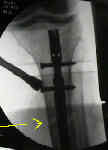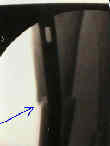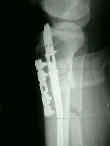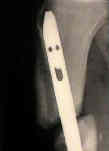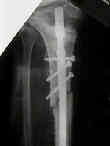- See: IM Nailing of Tibia Fractures
- Discussion:
- IM naling of these fractures is technically difficult and often results in malalignment;
- other options include: external fixation for open fractures;
- Intramedullary nailing versus percutaneous locked plating of extra-articular proximal tibial fractures: comparison of 56 cases.
- Semi Extended Posititon for IM Nailing:
 - Prevention of Valgus Angulation at the Frx site:
- Prevention of Valgus Angulation at the Frx site:
- this complication results from a erroneous medial starting point (as seen on the AP view)
- w/ proximal tibial fractures it is important to insert the nail slightly more lateral than is usual in order to avoid a
valgus deformity such as is seen here;
- AP width of the tibia is narrower on the medial side than on the lateral side, and therefore the medial cortex of the
tibia forces the nail laterally, causing the fracture to fall into valgus;
- on the AP view nails should be inserted in line with the medial edge of the lateral tibial spine;
- will prevent valgus angulation at the fracture site, but will also help avoid tendency for anterior translation
of proximal fragment (since saggital tibial width is larger laterally than medially (as is seen on cross
sectional analysis of tibia);
- blocking screw:
- a blocking screw can be inserted in the distal aspect of the proximal segment, at a point just lateral to the central axis of the proximal
tibia (not the central axis of the fracture);
- hence the nail passes medial to the blocking screw;
- references:
- The use of Poller screws as blocking screws in stabilising tibial fractures treated with small diameter intramedullary nails.
- The mechanical effect of blocking screws ("Poller screws") in stabilizing tibia fractures with short proximal or distal fragments after insertion of small-diameter intramedullary nails.
- Fractures of the proximal third of the tibial shaft treated with intramedullary nails and blocking screws.
- Intramedullary Nailing of Proximal Third Tibial Fractures: Techniques to Improve Reduction
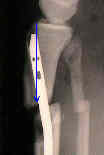
- Prevention of Anterior Translation of Proximal Fragment:
- the main complication of nailing proximal third fractures is anterior translation and angulation of the proximal fragment;
- nail configuration:
- fractures that are proximal to bend in nail, will cause proximal frx fragment to translate anteriorly upto 1 cm;
- it has been observed that the proximal bend in the nail acts as a wedge which displaces the proximal fragment
anteriorly as the nail is driven distally;
- use of a nail with a more proximally based bend has less of a wedging effect;
- references:
- Intramedullary devices for tibial fracture stabilization.
- Influences of some design parameters on the biomechanics of the unreamed tibial intramedullary nail.
- posterior starting hole in the proximal fragment:
- results from IM nail insertion posterior to the central axis of the proximal fragment's medullary canal;
- amount of anterior translation of the proximal fragment (relative to the distal fragment) is directly related to the amount
of eccentric nail placement in the posterior fragment;
- the solution for this problem requires entry portal of the nail be made as colinear w/ axis of the IM canal as possible;
- technique measures to avoid anterior malalignment:
- avoid flexion of the proximal fragment:
- hyperflexion of knee, better presents proximal tibial surface for nail insertion, but it also tends to flex proximal tibial
fragment (through extensor mechanism);
- this flexion of the proximal tibial fragment makes it difficult to direct the nail parallel to the anteiror tibial cortical surface;
- Technique Considerations:
- starting hole:
- AP plane: lateral entry hole: anatomy of the proximal tibia favors a slightly lateral starting point:
- the proximal tibia is triangular in shape and is more narrow medially;
- placement in line w/ the medial face of the lateral tibial spine, maximizes the effective saggital diameter of the
tibia, which reduces "wedging effect" of the anterior nail bow;
- in the report by Tornetta P (OTA, 1999), authors note that anatomic safe zone (lies on lateral plateau between medial
and lateral meniscus;
- the authors correlate this anatomic landmark with a radiographic landmark;
- the authors noted that on AP radiographs the safe zone was in line with the medial aspect of the lateral tibial spine;
- consensus safe zone: 1 cm lateral to the midline of the plateau or 3 mm lateral to the center of the tibial tubercle;
- ref: Intramedullary Nailing of Tibial Fractures: Review of Surgical Techniques and Description of a Percutaneous Lateral Suprapatellar Approach
- lateral plane: proximal and posterior entry hole: (needs to be more proximal and more colineal with meduallar canal);
- place the entry hole on top of the tibial plateau several mm farther posterior than usual;
- the starting holes should not be so posterior that it encroaches on the joint surface;
- this facilitates placement of reamers and the nail in a direction parallel to the anterior cortical surface;
- blocking screws:
- allows the nail to remain to the anterior cortex as the nail is inserted down the canal;
- blocking screw is placed in the posterior half of the proximal part of the tibia (just posterior to the central axis) in the sagittal
plane from a medial to lateral direction;
- references:
- The use of Poller screws as blocking screws in stabilising tibial fractures treated with small diameter intramedullary nails.
- The mechanical effect of blocking screws ("Poller screws") in stabilizing tibia fractures with short proximal or distal fragments after insertion of small-diameter intramedullary nails.
- Fractures of the proximal third of the tibial shaft treated with intramedullary nails and blocking screws.
- Intramedullary Nailing of Proximal Third Tibial Fractures: Techniques to Improve Reduction
- direction of reaming:
- use of sequentially sized straight "T" handled reamers to develop a central path down the medullary canal of the proximal fragment;
- if there is difficulty in reaming out the cancellous bone adjacent to the anterior tibial cortex, then consider retrograde
reaming (see below) or consider removing this bone with a currette;
- ensure that the IM nail passes thru the central portion of the proximal fragment (using flouro) prior to passing the nail thru the distal fragment;
- if there is difficulty in passing the IM nail thru the central portion of the canal, then consider inserting a 4.5 mm bicortical "blocking
screw" just posterior to the central portion of the IM canal;
- hazards: when trying to obtain a proximal-posterior starting hole there is a tendency to lever the awl anteriorly, which can
result in anterior wall blowout;
- try to obtain the most proximal-posterior starting hole possible, which does not require levering of the awl (or the nail);
- temporary anatomic reduction:
- some authors advocate a temporary near anatomic reduction prior to reaming and nail insertion;
- in closed frx, this may consist of a universal distractor (w/ one pin beneath the knee and one above the ankle);
- in open frx, this may consist of bone reduction clamps;
- as noted by Lang, et al (1995), however, even with an anatomic reduction (held w/ bone reduction clamps, anterior translation
of the proximal fragment occured w/ final seating of the nail;
- this was most likely due to eccentric reaming and nail insertion along the back of the medullary canal;
- Proximal third tibial shaft fractures. Should they be nailed?
- case examples:
- in the following example, the frx was open which allowed a Loman (turkey claw) clamp across the fracture, which prevented frx
site displacement as the nail was driven across;
- both proximal and distal interlocks were inserted prior to removing the clamp;
- as expected, a small amount of displacement occurred once the clamp was removed;
- rigid anatomic reduction of the proximal fracture can be achieved w/ a plate (and unicortical screws) or with lag screws;
- in either case, the fixation must be left in place, since experience has shown that redisplacement will occur when the fixation is removed;
- if plates are used, consider a 4 hole 3.5 LC-DCP or pelvic recon plate w/ unicortical screws;
- medial or lateral plate position depends on the status of the soft tissues;
- this stategy is most useful for segmental tibial fractures but is less useful for open fractures (due to the increased risk of infection);
- in the case of a comminuted proximal tibial frx w/ a butterfly fragment, consider lag screws fixation of the butterfly
fragment to the proximal tibia;
- this adds length to the proximal tibial fragment, preventing frx displacement as the nail engages the distal cortex;
- consider application of a plate to maintain reduction;
- reference:
- Anterior unicortical buttress plating in conjunction with an unreamed interlocking intramedullary nail for treatment of very proximal tibial diaphyseal fractures.
- Provisional unicortical plating with reamed intramedullary nailing in segmental tibial fractures involving the high proximal metaphysis.
- Complications:
- these fractures may be associated w/ peroneal nerve palsy;
Proximal third tibial shaft fractures. Should they be nailed?
Technical Tricks: A technique for intramedullary nailing of proximal third tibia fractures.
Proximal one third tibial fracture solutions. Benirschke SK, et al. Orthop Trans. 1995;18:1055-1056.
Intramedullary nailing of proximal quarter tibial fractures.
Anterior unicortical buttress plating in conjunction with an unreamed interlocking intramedullary nail for treatment of very proximal tibial diaphyseal fractures.
Proximal tibial fracture stability with intramedullary nail fixation using oblique interlocking screws.
Temporary intra-operative reduction techniques for tibial fracture fixation: A review of the literature.
Intramedullary Nailing of Proximal Third Tibial Fractures: Techniques to Improve Reduction



